Paestum tourist information
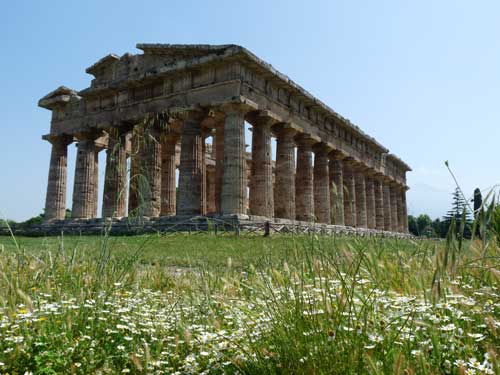 Paestum is a truly enchanting and atmospheric place, and a ‘must’ on any classical tour of Italy. Just south of the Sorrento peninsula and Amalfi Coast, and a mile inland, this is a haunting archaeological site where three Greek temples stand in the middle of the countryside. Paestum is listed as a UNESCO World Heritage Site.
Paestum is a truly enchanting and atmospheric place, and a ‘must’ on any classical tour of Italy. Just south of the Sorrento peninsula and Amalfi Coast, and a mile inland, this is a haunting archaeological site where three Greek temples stand in the middle of the countryside. Paestum is listed as a UNESCO World Heritage Site.
The history of Paestum
The town of Poseidonia – later called Paestum – was built by Greek colonists from Sybaris, an earlier Greek city in southern Italy, in around 600BC. It grew and prospered and now has among the most extensive remains of Magna Graecia (Magna Grecia in Italian). In 410BC the town was conquered by the Lucanians, a native Italian people, then in 273BC the Romans took over, changed the name to Paestum and began their own building programme. As the Roman Empire collapsed, Paestum crumbled. Malaria and Saracen raids led to the near-abandonment of the town and the development of Capaccio, a safer hillside settlement.
Paestum itself was pretty much forgotten. An information board outside the old church gives a poignant image of the locale as an abandoned wilderness frequented by brigands. Things changed with the eighteenth-century rediscovery of the temples by road-builders coupled with a revival of interest in antiquities and the visits of Grand Tourists and indefatigable travellers like Shelley and Goethe. The classical name Paestum was revived (though Capaccio is still the local authority). Nowadays most of the vanished city of Poseidonia-Paestum is hidden under agricultural land. The ancient city walls, constructed with massive stone blocks, encircle a large area of countryside, much of it unexcavated. Right in the middle is the archaeological zone open to the public, and a few later buildings housing small tourist businesses.
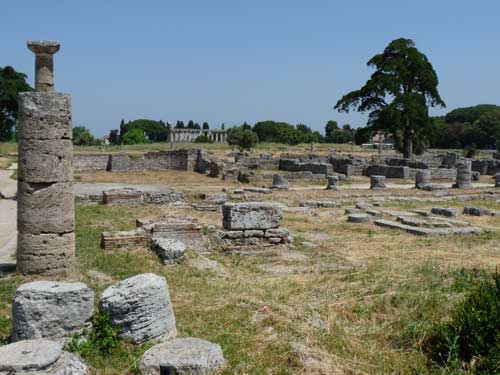
What is there at Paestum?
The archaeological site at Paestum covers a large area and takes as much as two hours to explore thoroughly. A street runs along the railings outside the site and here, in the middle of surprisingly rural surroundings, you’ll find a busy little row of souvenir shops and several bars with outside tables serving drinks, rolls, ice creams and snacks. For more filling evening meals, you can walk further along the road to find a pizzeria and – on Via Tavernelle – a couple of restaurants including the excellent Granaio dei Casabella hotel/restaurant where we ate and slept.
The cluster of buildings near the excavations doesn’t have the size or atmosphere of a normal residential town or village, but there is one little square, where you’ll find the pretty and historic local church, a tourist information office, a cafe and a drinking-water fountain. And the early evening, when we visited, brought forth a typical Italian passeggiata, with families strolling along the street and chatting with friends. The museum is opposite the archaeological site and again it takes some time to tour it attentively. Some of the nicest features of Paestum are the surprises: a white peacock stalking over a field, roses blooming to evoke the past (ancient Paestum was famous for its roses), the stretches of picturesque large-blocked city wall.
Although you can see the sights of Paestum in a day trip, the atmosphere is so magical and so peaceful that it really merits an overnight stay. We arrived in the early evening, saw the temples shimmering pink in the sunset, enjoyed a relaxing drink at a bar with views of the archaeological site, then had a fine meal at our hotel, where our bedroom window had a view of a temple illuminated in the dark. The next day we were able to explore the site in a leisurely fashion, visit the museum and eat lunch before catching the train onwards. Although seasoned travellers, we found Paestum to be a really special and memorable experience.
If you are staying longer, and have a car, you will find other interesting ruins and another museum within easy reach of Paestum. The Heraion, a Sanctuary of Hera, by the mouth of the river Sele, dates to the sixth century BC and has its own museum (limited opening hours), though many of the local finds are in the main Paestum museum. Paestum’s UNESCO listing incorporates the National Park of the Cilento, the ruins of the Greek city of Elea/Velia, and the Certosa (Charterhouse) at Padula, and these make good starting-points for a visitor exploring the area.
Archaeological site and museum
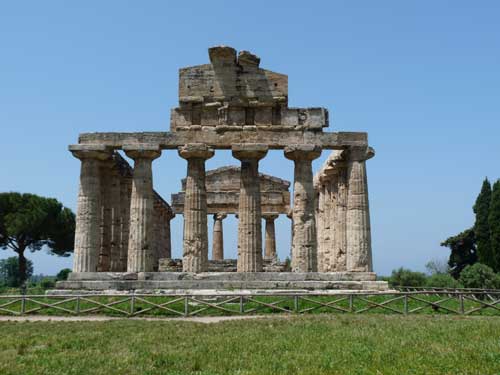
You can buy separate tickets for the archaeological site and the museum but if you’re visiting both it is cheaper to purchase a combined ticket. There are various categories of discount, as at all Italian state-run monuments. The outdoors attraction is open daily; the museum is closed on the first and third Mondays of each month (check the latest times/days before you travel).
The archaeological area at Paestum covers the heart of the ancient city. The most dramatic sights, which led to the site’s rediscovery, are the three Doric temples. Roofless, but still standing, these are among the greatest archaeological monuments in Italy. The smallest of the three, standing on a small rise, was dedicated to Athena, though it’s also known as the Temple of Ceres. This temple later became a Christian church. The oldest of the buildings, the Temple of Hera, is at the further end of the site and not far away is the most imposing and well-preserved, the Temple of Neptune (or Poseidon). One of the finest surviving examples of a Greek temple, this is a huge and dramatic building, surrounded by steps and a colonnade of majestic dimensions. The ruin has no roof, but the pediments and ornamentation give a good idea of how the building would have looked.
Paestum is not all about temples, though. The extensive area which is open to the public includes civic buildings, the Roman forum and amphitheatre, paved roadways and ruins of residential buildings. Pathways are kept clear, but tall grass and flowers drown many of the low walls and tumbled masonry. Visitors can pick their way through overgrown areas for picturesque views and sprawling, half-uncovered Roman and Greek remains. The most intriguing spot is the ‘Heroon’. This was probably a kind of symbolic tomb of a city founder or mythical hero. Inside a stone chamber dating to the sixth century BC, archaeologists found offerings including large, beautiful vases containing honey, now displayed in the museum.
The museum at Paestum is just opposite the archaeological site. Exhibition rooms are quite rambling and extend over several floors, so it takes a bit of investigation in order to see everything that is on display. The museum houses sections of pediment, decoration and sculptures from the archaeological area and from other nearby sites, mostly dating to the Greek era and some showing a clear relationship with Etruscan artworks from central Italy. The museum also contains paintings and grave goods from tombs in and around Paestum. The most famous of these is the fresco from the ‘Tomb of the Diver’, a remarkable oddity. This is the only extant wall-painting from a Greek tomb, and shows a simple image of a solitary man diving into water. Other tomb-paintings in the museum date from the Lucanian era and show scenes of fighting, hunting and celebration.
If you are visiting Paestum and are interested in the site’s history and context, it is worth taking a guidebook or purchasing one on the spot. There are bilingual information boards around the temples, which help to explain the ruins. It is also worth allowing time to tour the museum, even if you focus only on highlights like the tomb-paintings.
Paestum travel and transport
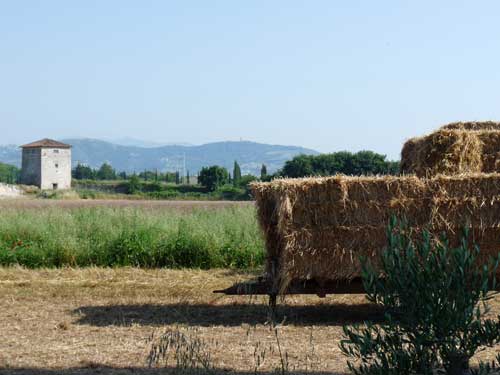
Paestum is on a railway line connecting Salerno with Sapri to the south. If you are coming from the Amalfi Coast, take a boat or bus to Salerno before catching the train. From Naples and northern parts of Italy, change in Salerno. The journey from Salerno takes just over half an hour. There are signs announcing ‘Paestum’ along the platforms, but it’s not a bad idea to check the order of stations and count the number of stops to make sure you know when you’ve arrived. There is no ticket office at Paestum station, so you should either buy your return train ticket in advance, or visit a useful shop by the archaeological site which sells rail tickets. Trains are not very frequent, so plan your journey in advance.
The station is by one of the old gateways into the historic town. Nowadays this lies in the countryside and when you walk through the archway, instead of a busy city you’ll find fields, haystacks, birds and butterflies. The archaeological area lies straight ahead, through the archway and a 15-minute walk down a quiet country lane. Arriving like this, on foot, you really appreciate the idyllic setting; so different from the nearby towns of Naples and Salerno.
Paestum is also served by buses from Salerno, run by local transport companies CSTP and Giuliano (see links panel).
Accommodation
Paestum can be visited as a day-trip from Naples, Salerno or the Amalfi Coast, but holidaymakers on a tour of Italy may find it a good overnight stay on the journey south. Public transport and road links mean that it would also be possible to plan a longer stay based in Paestum and exploring the surrounding area.
There is not a great deal of accommodation close to the archaeological site at Paestum. We stayed in a very good country-style hotel, the Granaio dei Casabella, just a short walk away, and would recommend it as a comfortable base for visiting the ruins. Other, more modern hotels are grouped close to the seaside around a mile away.
> Paestum: Granaio dei Casabella
> More hotels around Paestum
On this site
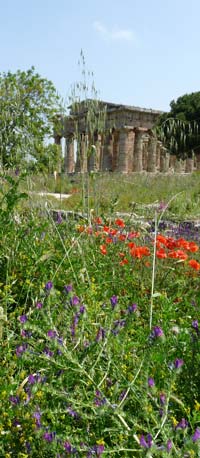
South to Calabria: a travel itinerary starting in Paestum
Useful links